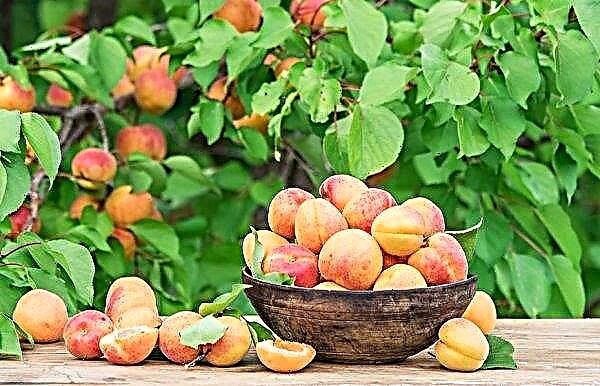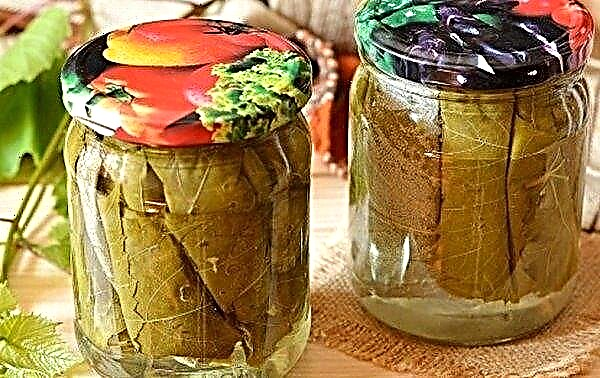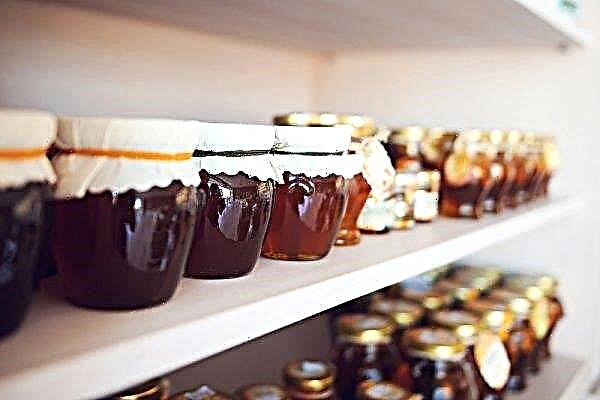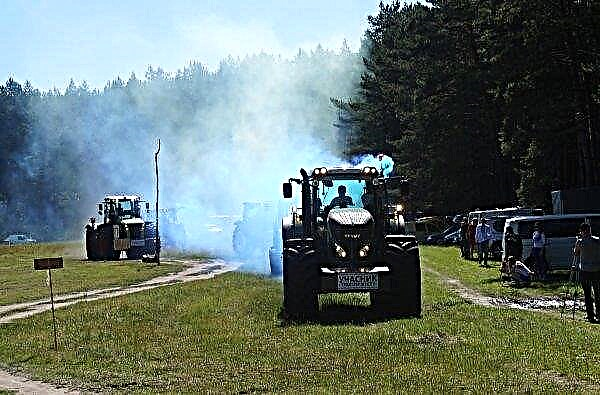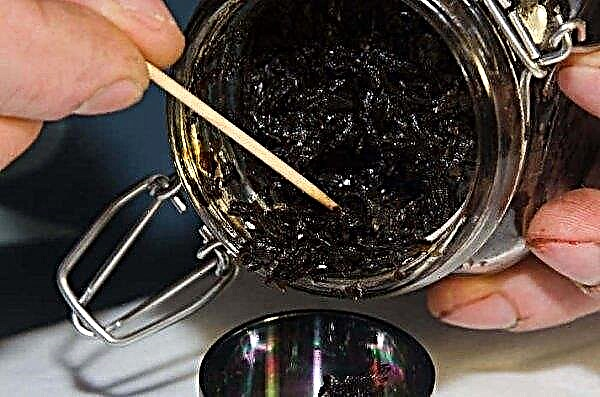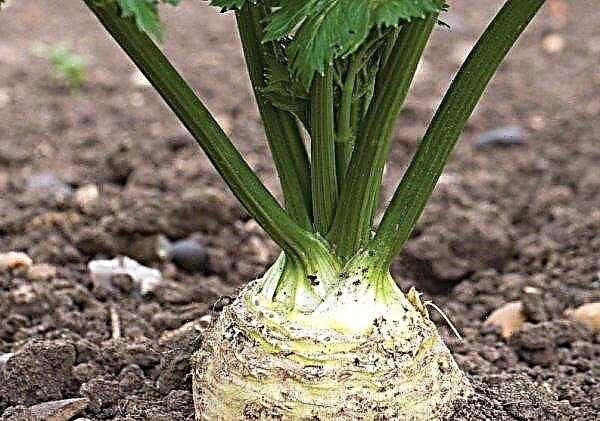When decorating garden beds, many gardeners prefer combinations of spring-flowering and summer-flowering plants. Most often on the site you can find irises, presented in different colors. To frame borders and decorate verandas, dwarf irises are usually preferred, the features of which will be discussed later.
Description and variety varieties
Dwarf iris is a low-growing herbaceous plant, 20–40 cm high, leaves are long, pointed, smooth and dense green, located right at the rhizome, grow vertically upwards. Buds may differ, depending on the variety, mainly represented by white-yellow and purple-blue colors.
Culture begins to bloom half a month earlier than its tall counterparts.
Did you know? Unusual, despite their small stature, dwarf irises produce buds that are exactly the same size as tall varieties.
Blue denim
Variety Blue Denim is one of the favorites of gardeners. This variety is called so, thanks to the pale blue tint of its petals. The bush usually grows evenly, stretching 20-25 cm in height.
Flowers appear quite early, already in mid-May, petals with terry edges, sky blue with small veins of a dark blue hue.
 The aroma of this flower is characteristic, but light, unobtrusive in its intensity
The aroma of this flower is characteristic, but light, unobtrusive in its intensity
Hard Az Rock
Hard As A Rock is an iris variety whose name speaks for itself, a bright, extraordinary, eye-catching flower with a pronounced aroma.
Did you know? The first mention of irises was discovered in Crete, where archaeologists managed to find an ancient fresco depicting this flower. The age of the relic is about 4000 years.
The height of the stems reaches 30 cm. The buds are large, with a multi-color, complex color: a spot of violet-cherry hue “spreads” along the pale yellow surface, along the very edge of the petal the color turns into ink-black. The beard of the bud can be orange in the neck with a transition in purple to the edge.
 Iris blooms early, begins in May, continuing it during the summer
Iris blooms early, begins in May, continuing it during the summer
Cherry garden
A favorite of gardeners, a dwarf bearded iris variety Cherry Garden. A noble, unpretentious flower in care, can often be found in flower beds.
The bush grows very quickly to full size with a height of peduncles of about 30 cm. The flowers are large with a uniform purple color, the beard is slightly lighter than the petals, lilac-blue. The first buds appear closer to June.

Healing properties
Irises, or rather their rhizomes, have long been famous for their healing properties. In folk medicine, there are still many recipes using this ingredient.
Important! For medical use, only certain plant varieties are allowed, including Iris Germanic and Iris Florentine, therefore, before applying the rhizome of the plant, it is necessary to consult with specialists.
The chemical composition of the iris root includes monoterpene ketone iron, resins, fatty oils, acids (benzoic, myristic), tannins, vitamin C, starch, flavonoids.
- All these substances cause a wide range of therapeutic effects of iris:
- treatment of respiratory diseases (bronchitis, tonsillitis, pneumonia);
- relief from gastritis, liver and gall bladder diseases, colic, normalization of the gastrointestinal tract;
- relieving acute toothache;
- general warming and diaphoretic action for colds.
The rhizome of the plant is used in the form of decoctions, an oil solution, dried and triturated.
Growing Features
Dwarf irises are rightfully considered the most unpretentious flowers grown in garden plots, they tolerate drought and frost well, are not too demanding on the composition of the soil, however, there are general recommendations for agricultural technology and caring for them.
Video: Dwarf irises
Landing rules
In order for dwarf irises to take root well and grow successfully, you need to fulfill a few simple landing requirements:
- it is better to choose a site well lit by the sun, light, preferably from the south side, on a slope or hill (it is undesirable to plant in lowlands);
- the soil should be fertile and loose, neutral in pH;
- it is important to ensure soil drainage, since moisture stagnation is detrimental to the root system;
- dig the selected area with the introduction of nitrogen and phosphorus fertilizers;
- planting is carried out in the warm season, from spring (after completion of frost) to the end of summer;
- the bushes must be placed in holes located at a distance of 30 cm from each other, leaving the neck of the rhizome above the surface of the soil.

The subtleties of care
It is not difficult to care for irises, while the seedlings are small, they only need moderate watering in dry weather and periodic gentle loosening of the soil to improve air exchange.
Important! Before planting, cuttings of seedlings must be decontaminated by soaking them in a pale pink solution of potassium permanganate for 2 hours.
Adult plants in addition to watering need additional nutrition:
- in the spring, before the buds (in April) appear to grow greens, irises are fed with any nitrogen fertilizer (for example, ammonium nitrate at the rate of 1 g of substance per 1 liter of water);
- with the beginning of bud formation, nitrogen is no longer necessary, but potassium is required to enhance and prolong flowering (for example, potassium sulfate, according to the instructions on the package);
- phosphorus fertilizers can be applied in the middle of the growing season along with potash fertilizers, as well as in the fall (for example, superphosphate, at a dosage specified by the manufacturer).

During the flowering period from the plant it is necessary to remove wilted buds in a timely manner, this will accelerate the formation of new. After the bush has finally bloomed by autumn, you need to cut off all the peduncles.
 Before wintering, the bushes are cut off about half the length of the bushes (leave at least 10 cm)
Before wintering, the bushes are cut off about half the length of the bushes (leave at least 10 cm)
In the third year, when the root system grows, you can spend the planting of the culture. In this case, the foliage is cut to 2/3 of the length, then the root is removed from the ground and divided into several parts so that at least 2 leaf sockets remain on each of them.
Diseases and Pests
In general, the advantage of dwarf iris is its resistance to pests and diseases characteristic of many flowering plants. Nevertheless, there are ailments that can ruin a culture.
Bacteriosis or iris rot rhizome. It is known that the root system of this plant is very sensitive to waterlogging. It happens that with excess moisture or a thickened planting, a large number of pathogenic bacteria develop in the root area, which leads to its decay.
 It is not easy to notice the disease, it develops rapidly, the rhizome begins to rot, it smells unpleasant, the leaves begin to turn yellow and slope to the ground
It is not easy to notice the disease, it develops rapidly, the rhizome begins to rot, it smells unpleasant, the leaves begin to turn yellow and slope to the ground
To treat the plant, it is necessary to cut out all the root areas affected by bacteriosis to healthy tissue, treat the incisions with a solution of potassium permanganate, and then treat with a fungicide (for example, Fundazol) in the form of a powder or 10% hydrogen peroxide. After treatment, you need to leave the plant in the air until healing, you can not bury it in the ground.
A dangerous pest for culture is the iris fly. It is a parasite that lays its eggs in the buds of a plant. When the larvae appear, they begin to eat the petals of the flower that has not yet blossomed and lead to its death. The spread of larvae can lead to rotting of all buds and stop flowering.
 If the lesion was found, you need to remove from the bush and burn all the damaged flowers
If the lesion was found, you need to remove from the bush and burn all the damaged flowers
To prevent infection at the very beginning of spring (before the active formation of buds), it is necessary to carry out chemical treatment with insecticides (for example, "Aktara"). With an increased risk of defeat by the pest, the procedure can be repeated after the release of peduncles.
Iris in landscape design
Dwarf irises are unique in their own way. From the point of view of landscape design, they look equally good with tall plants, and with short ones.
The early onset of flowering makes it possible to use them for decoration of fences and framing garden paths in combination with delicate daffodils or tulips. In summer, they look great on large flower beds with forget-me-nots or phlox. "Cockerels" are also great for framing small flower beds with tall plants, such as goldenrod.

The culture can be used separately from other colors.. So, a flower planted in decorative flowerpots and flowerpots, copes with decorating a veranda, terrace or low curb.
Thus, having become acquainted with the different varieties of dwarf irises and the basics of caring for them, we can conclude that this plant has an optimal set of qualities of an ideal garden culture. Beauty, unpretentiousness, a variety of types and universality provide him huge popularity among gardeners.


